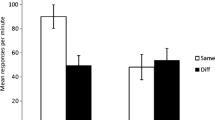Abstract
Two auditory (1- and 2-kHz tones) and two visual (red and white lights) stimuli were used as discriminanda in classical heart rate and instrumental conditioning situations employing the same pigeons as subjects. It was found that while discrimination of the tones was demonstrated easily in the classical situation, a discrimination of the colors was not. Conversely, while discrimination of the colors was achieved quickly in the instrumental situation, a discrimination of the tones was not. These results are discussed in the context of specific learning constraints and viewed as consequences of the adaptation of pigeons to their normal environment.
Similar content being viewed by others
Reference Note
EMMERTON, J. A. 1975. The colour vision of the pigeon. Unpublished doctoral thesis, University of Durham, U. K.
References
BITTERMAN, M. E. 1967. The comparative analysis of learning. Science, 188, 699–709.
BLOUGH, D. S. 1957. Spectral sensitivity in the pigeon. Journal of the Optical Society of America, 47, 827–833.
BLOUGH, D. S. 1969. Attention shifts in a maintained discrimination. Science, 166, 125–126.
COHEN, D. H., & TRAUNER, D. A. 1969. Studies of avian visual pathways involved in cardiac conditioning. Experimental Brain Research, 7, 133–142.
DAWKINS, M. 1974. Shifts of “attention” in chicks during feeding. Animal Behaviour, 19, 575–582.
DELIUS, J. D., & TARPY, R. M. 1974. Stimulus control of heart-rate by auditory frequency and auditory pattern in pigeons. Journal of the Experimental Analysis of Behavior, 21, 297–306.
DURKOVIC, R. G., & COHEN, D. H. 1969. Effects of rostral midbrain lesions on conditioning of heart and respiratory rate in pigeons. Journal of Comparative and Physiological Psych ology, 68, 184–192.
FOREE, D. D., & Lpolordo, V. M. 1973. Attention in the pigeon: Differential effects of food-getting versus shock-avoidance procedures. Journal of Comparative and Physiological Psychology, 85, 551–558.
GARCIA, J., & KOELLING, R. A. 1966. Relation of cue to consequence in avoidance learning. Psychonomic Science, 4, 123–124.
HEISE, G. A. 1953. Auditory threshold in pigeons. American Journal of Psychology, 66, 1–19.
HINDE, R. A., & HINDE-STEVENSON, J. (Eds.) 1973. Constraints on learning. London: Academic Press.
JENKINS, H. M., & HARRISON, R. H. 1960. Effect of discrimination training on auditory generalization. Journal of Experimental Psychology, 59, 246–253.
KONISHI, M. 1973. Locatable and nonlocatable acoustic signals for barn owls. The American Naturalist, 107, 775–785.
LOLORDO, V. M., & FURROW, D. R. 1976. Control by the auditory or the visual element of a compound stimulus: Effects of feedback. Journal of the Experimental Analysis of behavior, 25, 251–256.
MARTIN, G. R. 1974. Color vision in the tawny owl (Strix aluco). Journal of Comparative and Physiological Psychology, 86, 133–141.
SCHLEIDT, W. M. 1961. Reaktionen von Truthühnern auf fliegende Raubvögel und Versuche zur Analyse ihrer A Ams’. Zeitschrift für Tierpsychologie, 18, 534–560.
SELIGMAN, M. E. P. 1970. On the generality of the laws of learning. Psychological Review, 77, 406–418.
SHETTLEWORTH, S. J. 1972. Constraints on learning. Advances in the Study of Behavior, 4, 1–68.
TRAPOLD, M. A., & WINOKUR, S. 1967. Transfer from classical conditioning and extinction to acquisition, extinction and stimulus generalization of a positively reinforced instrumental response. Journal of Experimental Psychology, 73, 517–525.
Author information
Authors and Affiliations
Additional information
The work was supported by a Science Research Council (London) grant. It was carried out while the authors were at the Department of Psychology, University of Durham, England. We thank Dr. A. Still for advice and A. Perry, D. Harper and M. Harper, D. Barton, M. Rollings and J. Dobson for assistance of various kinds. We are also grateful to Prof. M. E. Bitterman and Dr. I. Schmidt for criticizing an earlier draft.
Rights and permissions
About this article
Cite this article
Delius, J.D., Emmerton, J. Stimulus-Dependent Asymmetry in Classical and Instrumental Discrimination Learning by Pigeons. Psychol Rec 28, 425–434 (1978). https://doi.org/10.1007/BF03394554
Published:
Issue Date:
DOI: https://doi.org/10.1007/BF03394554




